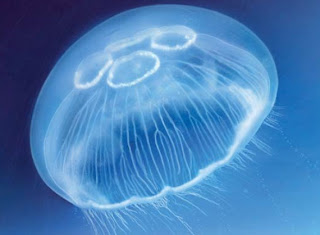Saturday, June 23, 2012
The Propulsion System of the Jellyfish
Jellyfish are at least 95 percent water and range in size from less than an inch to over six feet in diameter. Muscles propel many species along by rhythmically contracting and relaxing their bell-shaped body, somewhat like closing and opening an umbrella.
Scientists who study fluid dynamics have discovered that certain jellyfish, while not fast swimmers, have an intriguing method of propulsion. With each contraction of their body, the animals create a doughnut-shaped vortex, like a smoke ring, which they push away from themselves. The momentum of the rings creates an opposite reaction that propels the jellyfish forward, somewhat like a jet but with pulses of energy instead of a constant thrust. “It sounds simple,” says New Scientist magazine. “But the act of forming a vortex ring has proved very difficult to model mathematically.”
Researchers are studying the jellyfish’s propulsion system in order to build more efficient underwater vehicles. One researcher has already developed a four foot-long submarine that creates a wake similar to that of the jellyfish. The vehicle uses 30 percent less energy than a conventional propeller-driven unit. Another possible application involves the human heart. Because the movement of blood within a section of the heart generates vortex rings, abnormal vortices may reveal early signs of heart disease.
source:jw.org


 8:05 PM
8:05 PM
 Hmm
Hmm


 Posted in:
Posted in: 









0 comments:
Post a Comment